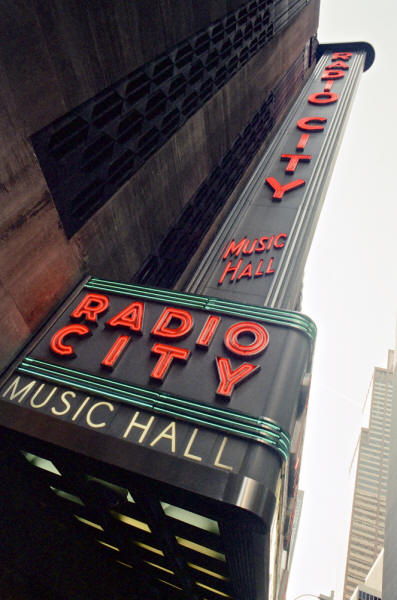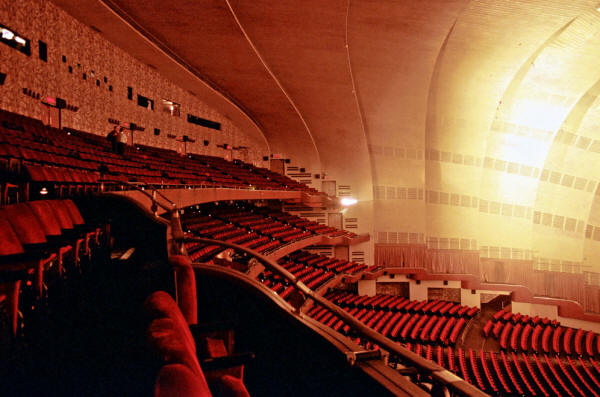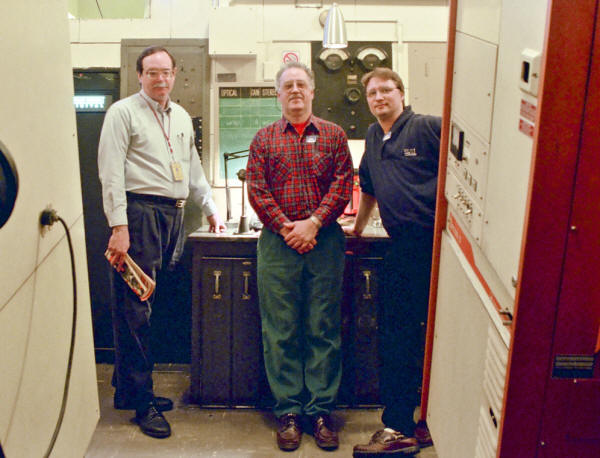Radio City Music Hall 70mm Film Presentations |
This article first appeared in |
| Written by: Mr. Bob Endres, Chief projectionist at The Hall. Pictures by: Thomas Hauerslev | Issue 58 - September 1999 |
|
|
Further in 70mm reading: |
|
|
|
|
|
|
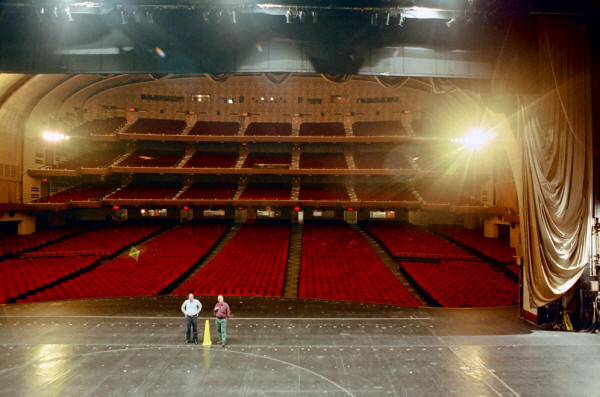 View
from the stage towards the auditorium. Picture taken from the
behind-the-screen projection booth. Note two people on the stage. View
from the stage towards the auditorium. Picture taken from the
behind-the-screen projection booth. Note two people on the stage. For the 1994 presentation of "The Lion King" a completely new sound system was installed. It features a Dolby CP-200 processor, QSC power amplifiers and JBL speakers. Each of the five bi-amped stage channels includes four low-frequency JBL speaker cabinets and three high-frequency horns. There are eight dual sub-woofer cabinets and 98 surround speakers. The surround speakers are positioned at the front of the first mezzanine to cover the middle of the orchestra, as well as on the side walls and rear of the orchestra and each of the three mezzanines above it. In addition to the surround delay built into the Dolby CP-200, two Audio Digital digital signal processors are incorporated to allow for four delay zones for the surrounds, which are divided into left and right banks. Total watt power output from the QSC amps is about 46,000 watts. The screen, or "picture sheet" at the Hall is 691/2´ x 341/2´ (21,2 x 10,5 m) and the full aspect ratio 70mm picture is 69´ x 31´ (21 x 9,4 m). The 1.85 70mm picture when run at maximum size is 63´ x 34´ (19,2 x 10,4 m). Because of the downward projection angle and the block-wide width of the house a matte white screen is used to avoid hot-spotting of the light. The lamphouses are made by Optical Radiation Co. and use 5,000 watt bulbs. |
|
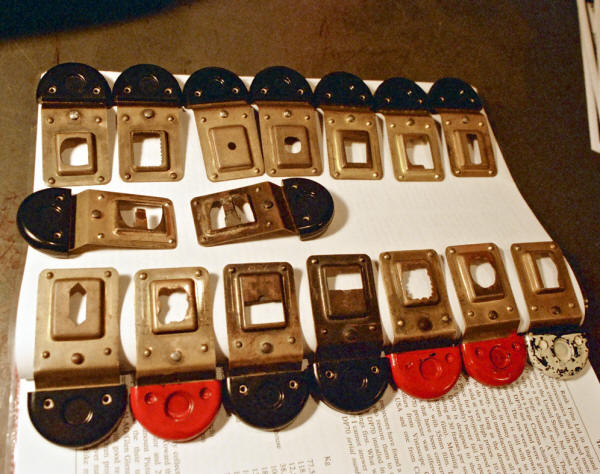 Bob Endres uses a lot of different masking plates to meet costumer demands on the screen. Bob Endres uses a lot of different masking plates to meet costumer demands on the screen.
The size of the auditorium presents a number of unique projection problems. Often prints are tailored to the theatre. This usually means printing them a little lighter in density to increase the apparent light on the screen. Since the projection throw is about 185´ to the screen, if the sound is in sync with the picture at the screen it is four frames out of sync at the back of the third mezzanine. If a 70mm print is being made for the Hall, the track is advanced one or two frames to put the sync point closer to the middle of the orchestra. (While the track can be advanced one frame in threading, if the loop between upper projector sprocket and the gate is made too big, the film becomes noisy and unstable -- thus it is preferable to have the track advanced in the recording process.) When Disney came in to look at test reels prior to the premiere of "The Lion King", we were able to run 70mm and 35mm reels of "Aladdin" locked together. It became obvious that the 35mm 1.85:1 picture size of 48´ x 26´ (14,6 x 7,9 m) couldn't compare with the larger image made possible by 70mm., but Disney still wanted to use the Dolby Digital track on the 35mm film, so it was decided to install platters, the widely used horizontal film handling units found in most cinemas today, at the number 4 projector (70mm) and number 5 projector (35mm) and lock the two machines together. We employed selsyns -- the devices used to electrically tie projectors together in the 3-D days of the 1950's -- to provide frame-for-frame synch. The 70mm machine would supply the picture (although the film also carried the usual magnetic stripes which were sounded and encoded in Dolby SR) and the 35mm Simplex X-L was equipped with a Dolby Digital reader and supplied the sound from a normal Dolby SR.D print. For the premiere, a second 70mm print was run "reel to reel" as a backup on the other two 70mm projectors in the booth. Although we didn't see the second 70mm print after the premiere, the rest of the run of "The Lion King" used the two projectors locked together. The same technique was used when Disney did the premiere of "101 Dalmatians" in 1996. |
|
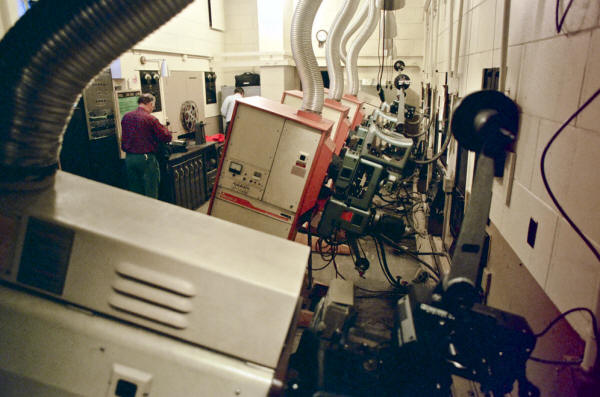 The
five projectors of The Hall, Simplex X-L's and Simplex 35/70's. The
five projectors of The Hall, Simplex X-L's and Simplex 35/70's.One of the more unusual 70mm applications at the Hall was the presentation of the French production of "Jesus Was His Name", a staging of the story of Christ told with live actors working below and in front of a large 78´ x 26´ (22,3 x 10 m) screen which carried a 70mm image both as scenic background and with actors integrated into the presentation. A special projection cabin was installed in the Orchestra of the Hall. The presentation used two Philips DP-75 projectors with 10,000 watt lamphouses. Two prints were run simultaneously, one as backup, from platters at 30 frames per second. While the film tracks carried some of the show sound, the projectors were locked to digital tape decks both by shaft encoders and by time code on the film mag tracks. The performers wore receivers which received cues to enable them to interact with the picture. The language of the presentation could be changed by changing the digital tape which was locked to the film. The use of the 30 f.p.s. film speed (not generally seen since the early Todd-AO presentations) enabled the larger wattage lamps to be used. The digital inter-locking to integrate live and film action made a technically fascinating interesting production. The opening film effect in the annual Christmas Spectacular is a 70mm clip of footage re-edited from "Santa Claus: The Movie" and also uses a special screen. We were asked to make the image as big as possible, so we run it on a 33´x 73´ screen hung downstage of our normal picture sheet. In order to increase the light for the larger image, the screen doesn't have the normal perforations used in screens when sound films are projected, thus gaining us about 8% more light. The sound accompanying the images of Santa flying over New York in his sleigh is provided by our orchestra playing an overture. The final images are of Santa flying through Rockefeller Center and landing on the roof (supposedly) of the Music Hall. As the sleigh crosses the roof on film the screen flies out to reveal a live Santa crossing a set of the roof on our stage. While the Hall was late installing 70mm equipment, it has proven to be the best and most impressive film format for the theatre. While watching a 35mm print in a 1.85 aspect ratio, the smallest image we project, is quite acceptable, it is obvious that it is well worth the trouble and expense to use 70mm for the most impact. |
|
| Go: back
- top - back issues Updated 22-01-25 |

